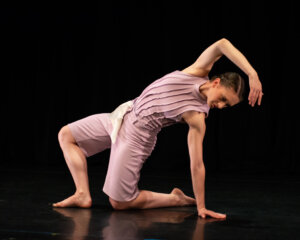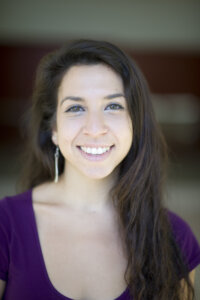An Israeli artist poses a bold question — what if Othello wasn’t at the center of ‘Othello’
Tel Aviv-based artist Hilla Ben Ari reimagines ‘The Moor’s Pavane’ by focusing on the key women characters

Graphic by Angelie Zaslavsky
Hilla Ben Ari is reimagining a reimagining. The Tel Aviv–based multidisciplinary artist’s new work for the Limón Dance Company was inspired by the late Jose Limón’s 1949 The Moor’s Pavane, which in itself was a pared-down retelling of Shakespeare’s Othello. And in this 21st-century interpretation, the women are the focus. The men, in fact, are nowhere to be seen.
The story of betrayal and jealousy that famously culminates in Othello and Iago murdering their wives looks a lot more closely at Desdemona and Emilia than Shakespeare or Limón ever did. In this deconstructed and reconstructed version, Desdemona and Emilia aren’t just secondary characters swept up in actions dictated by men or hapless victims of violence. This time they also resist. Now they are the protagonists.
I Must Be Circumstanced — which has its world premiere at New York Live Arts on Dec. 7 as part of the Limón Dance Company’s “Women’s Stories” program — takes its name from a line in the play in which another female character, Bianca, acquiesces to a male character’s authority and acknowledges her own powerlessness.
From Ben Ari’s reading, Shakespeare “planted some hints of some sort of feminist perspective, of the possibility to speak up,” she told me over Zoom from her home in Tel Aviv, toggling back and forth, sometimes mid-sentence, between English and Hebrew. “I take this hint and I put it at the center.”
The result is a piece unorthodox and novel in ways beyond just eliminating the men to train our eyes on the women: It features two Desdemonas and two Emilias, one pair of the characters dancing live onstage and the other pair as life-sized projections dancing on screens to form an unusual quartet. And it was created by a woman who is primarily a visual artist who’s exhibited her work in Israel and internationally. Though she has frequently turned to dancers to create video installations, Ben Ari has no formal dance training. I Must Be Circumstanced marks her very first work for the concert stage, and for a renowned modern dance company no less.
Charting a new path for the Limón company
Ben Ari was the first person Dante Puleio called when he was named the next artistic director of the Limón Dance Company in 2020. The two had overlapped at the University of Florida the previous year when Ben Ari was a visiting artist and Puleio was a visiting professor, and Puleio was captivated by Ben Ari’s work.

“I was just bowled over by what I was seeing. It was so simple, it was so clear, but so effective. It was like looking at paintings that were alive,” said Puleio, who’d danced with the Limón Dance Company for over a decade. “It was so intoxicating.”
When he got the call about taking over the company, Puleio immediately wondered what a collaboration with Ben Ari could look like. After all, he told me, Limón started out studying visual art, pivoting to dance only after he saw the works of El Greco and decided someone had already painted everything he wanted to paint. Ben Ari’s visual art background and “contemporary edge,” Puleio thought, might help the company tap into the rich intersection between visual art and dance at Limón’s roots while propelling it forward into a new era.
The world had just come to a screeching halt with the first lockdowns of the pandemic. “There was so much happening in that moment, and also nothing happening. And it really gave me a lot of time to focus on who Jose was and why he made the works he made,” said Puleio, who took the helm of the company nearly half a century after its founding choreographer’s death, adding that he felt a responsibility to be faithful to Limon’s legacy while also responding “to what’s happening in the world.”
Part of that meant thinking about the ways Limón explored his Mexican and Indigenous as well as European heritage and seeking out contemporary choreographers working in the same vein, which has so far led to a commission from Mexican dancemaker Raúl Tamez and others grappling with questions of identity. In the future, it may also mean unpacking Limón’s relationships with men and their influence on his art, and looking to queer choreographers navigating their sexuality and the world today.
It has also meant looking at the women who influenced and shaped Limón as well as the works he made about and in tribute to them — and bringing on women with unique perspectives and exciting artistic voices who can revisit Limón’s stories and tell new ones. Ben Ari’s work is the first in a trio of world premieres from female choreographers, to be followed by commissions from Kayla Farrish next year and Aszure Barton in 2025.
And though this is her first time working with a dance company, Ben Ari chose to revisit The Moor’s Pavane, a dance considered to be one of Limón’s masterpieces and perhaps even his signature.
Putting women at the center
Ben Ari says she was so excited when Puleio called to discuss a collaboration that she dived right in and watched every bit of Limón’s choreography she could find online.
“I immediately felt a connection to this specific work,” she said of The Moor’s Pavane, which distills Shakespeare’s tale down to four characters — Othello, Iago, Desdemona, and Emilia — dancing to baroque music by Henry Purcell. “I’m not from the dance field, so I think that this is what gave me the courage to take [on] a masterpiece.”

What caught her attention were the gender relationships, and she knew from the start that she wanted to work only with the female characters. “All their movements are sort of supplementary movements, supported movements, reacting to the action of the male roles,” she explained. “I was interested to see what happens if you take [away] who’s driving the narrative and let the muted motions speak.”
The main theme of Ben Ari’s work has long been the female body, how it’s perceived in cultural and social contexts and narratives, and what it’s like to move in a female body through the world. Though she’s a visual artist who studied ceramics at Bezalel Academy of Art and Design in Jerusalem before pursuing a master’s in comparative literature at Tel Aviv University, she was born with an orthopedic issue that made her acutely aware of her own physicality and how that experience shaped her view of the world. She left ceramics behind and went on to focus on print, sculpture, and video works, these last of which draw on theater and dance to explore questions about the body in motion and in stillness.
In recent years, she’s made a trilogy of video installations that engage with the work of forgotten Israeli artists. She paid tribute to her great uncle Nahum Benari, interpreting a lost play he wrote through a marginal female character, as well as to choreographer Heda Oren and artist Moshe Reifer, all of whom had died by the time she revisited their work.
“It’s like I’m adopting artistic mothers and fathers retroactively,” said Ben Ari. Her list now includes Jose Limón, who died in 1972, the year she was born.
Reimagining the reimagining
After years of conversation with Puleio through the COVID lockdowns, Ben Ari arrived for her first session with the Limón dancers in May. By then, she’d already studied video footage of The Moor’s Pavane and tested out her ideas with a few dancers in Israel. In the studios in New York City, they ran the original work without the men and started pulling it apart to make something new with echoes of the old, leaving plenty of time and space during rehearsals for discussion.
“It was very challenging on one hand to make a change to this, to come in and take apart something they know so well,” Ben Ari said. “It was important for them to understand, to really get what I want to explore in this work.”
By the end of Ben Ari’s second visit to New York in August, they spent three days filming the half of the hybrid choreography that would be projected on screen rather than performed live onstage.

For Puleio, it was only during this second residency that he could truly grasp how this concept would come to life. “It was the first time that I had seen the full quartet of it happen,” he said, and “I was like, ‘Oh, this is what this is gonna look like.”
He finally got a taste for what it would mean to have two dancers performing each role. “You get this really multifaceted exploration of these characters, and you see them for more than just who they are,” he said. “You see them for who they want to be and who they think they are and who they don’t want to be and what they regret doing.”
At an open rehearsal less than a week before the premiere, I could start to see it too. We were lucky it was a cloudy day, Ben Ari said, because we’d be able to make out the projections despite the enormous windows lining one side of the studio.
The dancers filed in, most taking a seat near the handful of visitors. Frances Lorraine Samson and Jessica Sgambelluri, the company members dancing the live versions of the characters, began warming up and practicing steps in front of two large screens set across the middle of the studio, angled in just slightly toward each other. With the lights dimmed, images of Mariah Gravelin and Savannah Spratt suddenly illuminated the screens, and there was a quartet. In two short excerpts they shared, the three-dimensional dancers and their two-dimensional counterparts moved together and separately — mirroring, diverging, and interacting.
But the rehearsal was still a few steps removed from what the full experience would be.
“It’s in my mind for so long. But almost until the last moment I won’t see everything together,” Ben Ari said.
When she and audiences do finally get to see it, she hopes it’s something Limón himself would have appreciated — an attempt by a grateful artist to be in dialogue with his masterpiece, to give it new life and renewed relevance in the next century. But not to replace it.




















